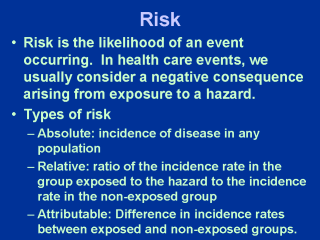| front |1 |2 |3 |4 |5 |6 |7 |8 |9 |10 |11 |12 |13 |14 |15 |16 |17 |18 |19 |20 |21 |22 |23 |review |
 |
The above concepts
of risk are very important in health care because they represents the strength of the
cause-effect relationship for a disease (or associated protective factor, e.g. exercise in
Type II diabetes). Absolute Risk is not very useful because there are always variations in exposure to hazards within a population or group. Absolute Risk is an average that cannot show the differences in disease incidence due to differences in exposure. Relative Risk is sometimes expressed as a percentage measure of proportionate increase or decrease (in the case of a protective agent) in disease rates in an exposed group. It is a more useful measure than Absolute Risk. Attributable Risk represents the risk arising from exposure to a particular hazard (or protective factor), I.e. is the risk attributable to the given hazard. |